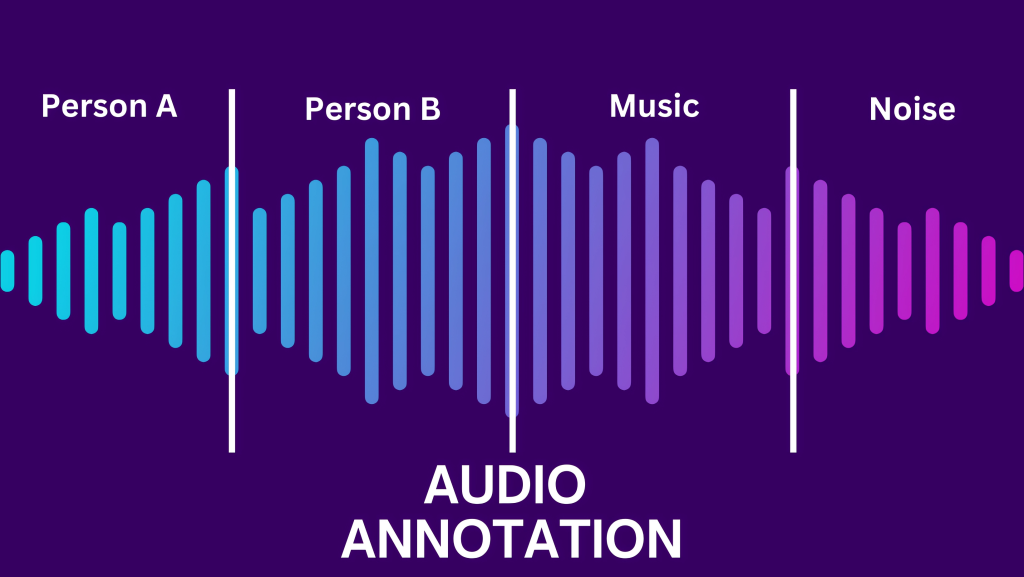How A…
Are you a fast reader? I bet you can read a text that’s been…

We all have seen virtual assistants giving accurate answers whenever we ask something. If you have Alexa, you must have tried asking it- Alexa, which is the nearest food court near me? Or Alexa, which is the best theatre in my city? As humans, it is easy to distinguish between words and understand the question, but how does Alexa know that we are asking for a food court and not food & court? The AI has to process your location, understand the context of your sentence and then come up with the correct answers. All this becomes possible due to audio data annotation- a subset of data labeling where ML systems can identify questions like these and retrieve accurate information.
In 2020, the market capitalization of AI/ML was $22.59 billion, and it is expected to reach $125 billion, growing at about 40% per year. ML model. ML models should have high-quality labeled/annotated data to make successful predictions. Audio annotation is a critical technique for building well-performing natural language processing (NLP) models that offer multiple benefits to organizations.
This blog will help you understand these points in detail.
Let’s dive in!

Audio annotation deals with making the sound or speech recognizable so that the chatbots and virtual assistant devices can comprehend it through machine learning. It is generally done for all types of speech, any sound that can be heard, and utilized for natural language processing.
Audio annotation involves classifying components of audio that come from people, animals, the environment, instruments, etc. Quite funny, but how would a machine know if it’s a human singing and it’s not the sound of an animal? It would require data, right?
Audio annotation makes the natural and unnatural sounds, including human conversations and animal roaring, understandable by machines. Thanks to all the quality data annotation and data collection, companies are making it easy for businesses to use AI.
In the audio/speech annotation process, the speech containing different types of sentences and words is annotated by the experts while relating them with the spoken words and their meaning. Experts keep the words and their meaning in their minds during annotation to get the most effective results.
Other than manual work, specialized softwares are also used to classify data for the annotation process. In the case of audio annotation, data scientists specify the labels or tags by using specialized software and pass the audio-specific information to the AI (NLP) model being trained.
Many times, people confuse audio transcription with audio annotation. It is essential to differentiate between transcription and annotation. Audio/Speech transcription is converting spoken language into written form. An annotation is any additional information being added to already existing data, be it a transcription of an audio file or any other text file. Usually, Audio annotation refers to both the transcription of the audio and annotation of the resulting text.

Statistics show that NLP is enterprises’ and businesses’ third most common form of artificial intelligence. In 2017, 53% of companies used some form of NLP. It is a huge market in terms of value and growth. The NLP market has generated more than $12 billion in revenue in 2020 and is expected to grow at a compound annual growth rate of about 25% from 2021-2025, increasing revenue to $43 billion. Undoubtedly, audio annotation is an important task today.
Chatbots are becoming popular and are being used by enterprises on a large scale. Customers are increasing, demanding fast customer service, and faster customer service is possible with chatbots and other AI. The success of chatbots is directly dependent on the quality of audio annotation. Hence quality annotation is necessary for retrieving the best results.
There are multiple techniques of data annotation. Let’s look at important ones:
Before you question how transcription comes into the annotation, we already mentioned that annotations typically involve transcription too. Transcribing speech into text is an essential part of developing NLP models. It includes converting speech into text.
It is one of the most important techniques used in audio annotation. Audio classification can help machines distinguish between the voices of animals and humans, sound characteristics. This type of audio labeling is essential for developing virtual assistants like Alexa, which uses the AI model and recognizes who is performing the voice command.
Data annotators separate the required sound from a given recording and label them with the keywords. This technique helps develop chatbots for enterprises helping them achieve better customer experience. Acgence makes it easy with its data annotation services.
You might have understood many of the applications of audio or speech annotation. Let’s see a few of them below.
One of the most widely and commonly used applications of data annotation is creating virtual assistants. Training virtual assistant on various audio annotated datasets makes it possible to create a voice assistant that can process the request accurately and retrieve the best results to give a better customer experience.
The model is trained on annotated audio datasets to develop a text-to-speech module that can convert digital text from files and documents into natural language speech. Training models using multi-lingual datasets can help you get more regional audiences.
Chatbots are one of customer support services’ most used and integral parts. It can be trained to interpret customers’ words and phrases to give them a better experience. Using audio annotated files to train models can simulate a natural conversation with humans. Top companies are already using this, and small businesses are slowly moving toward it.
Cleaning up your data earlier ensures that the data you feed your machines is of good quality. The better the quality of annotated data would be, the better you can retrieve results. We hope this blog cleared your doubts regarding data annotation and its use cases.
Acgence understands the value of quality AI training data. Therefore it helps its clients with the best AI data collection service and data transcription and AI data annotation services. No wonder top tech giants like Google, TCS, and Accenture are using our services. Acgence has made millions of labeled datasets available for AI training at a fraction of the cost. Check it out here.